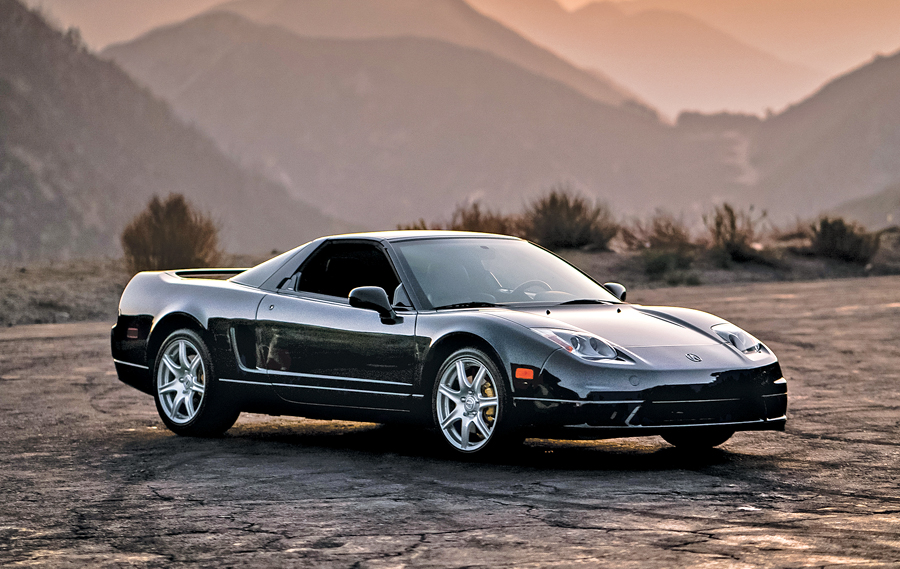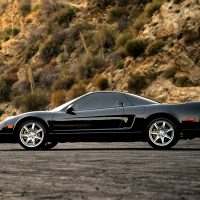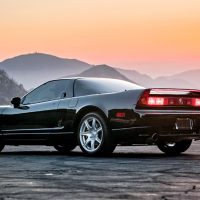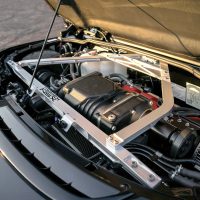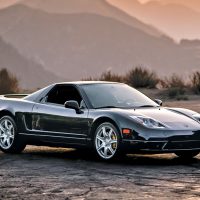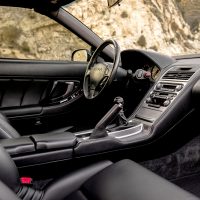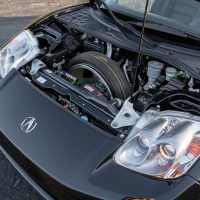- Dealer-installed/factory-authorized CompTech supercharger
- 6-speed manual transmission
- Offered in “exceptional like-new showroom condition”
- 4,600 original miles
- Service records and original books
- Air conditioning
- Power steering and brakes
- Radio
- Clean CARFAX
- Two extra sets of keys
SCM Analysis
Detailing
| Vehicle: | 2005 Acura NSX |
| Years Produced: | 1991–2005 |
| Number Produced: | 19,000 |
| Original List Price: | $90,000 (plus options) |
| SCM Valuation: | Median to date, $74,900; high sale, $144,100 (this car) |
| Tune Up Cost: | Approximately $600 (60k service) |
| Chassis Number Location: | Driver’s door sill |
| Engine Number Location: | Stamped in block near clutch housing at rear bank |
| Club Info: | NSX Club of America |
| Website: | http://www.nsxca.org |
| Alternatives: | 1989–94 Ferrari 348, 1989–94 Porsche Carrera 4, 2005–11 Lotus Elise |
| Investment Grade: | B |
This car, Lot 5158, sold at $144,100, including buyer’s premium, at Auctions America’s auction in Auburn, IN, on September 3, 2016.
The Acura NSX has always been in a class by itself. When it debuted in 1990 as a 1991 model, it was unlike anything the Japanese had ever offered before.
The Pininfarina-designed NSX came with a DOHC variable-valve-timing 3.0-liter normally aspirated V6, mid-mounted and mated to a 5-speed manual or 4-speed automatic gearbox. Manual cars were good for 270 horsepower, while automatic cars produced 252 horsepower. When equipped with the 5-speed manual transmission, the rev-happy engine blasted the NSX from 0 to 60 in 5.2 seconds, serenading the driver all the way to its 8,000-rpm redline.
By comparison, the Ferrari 348 of the same year took 5.6 seconds for its 300-horse V8 to pull the car to 60 mph. If that wasn’t enough to geld the stallion, the Acura cost about $60,000, while the Ferrari started at about $117,000. Ouch.
To get the handling dialed in, Honda brought in their leading F1 driver, Ayrton Senna, as a consultant. According to NSX lore, Senna convinced the Honda engineers to stiffen the frame. American Indy Car driver Bobby Rahal also consulted on the car’s suspension design.
Critical acclaim
After the NSX was launched, Car and Driver magazine ran a five-way contest with the top sports cars of the day, including the Lotus Esprit Turbo, Corvette ZR-1, Porsche 911 Carrera 4, Ferrari 348 tb, and the NSX. The editors evaluated acceleration, handling, interior, and build quality, essentially reviewing the whole ownership and driving experience. Not surprisingly, the Acura came out on top, with remarks like “Olympic-class handling” and “no bad habits.”
The NSX remained in production for an astonishing 15 years, upgrading to a 3.2-liter engine at 290 horsepower and 225 pound-feet of torque, a 6-speed manual transmission, and a targa-style removable top before the end. By 2005, sticker price on a new NSX with all the upgrades was still only about $90,000.
Shopping for an NSX
In some ways, the comparatively low purchase price was a burden to the NSX. By midway through a normal lifespan, early NSX models were trading at around $25,000 with reasonable miles. Of course, that means reasonable miles for a Honda product, not a Ferrari, so you can add a zero or two on the odometer without worry.
As a result, many NSX models endured a rougher-than-usual middle age for an exotic, including regular floggings on racetracks all over America. But that’s helped to boost the value of good low-mile cars today.
When it comes to maintenance, the NSX requires a timing belt and water pump service every 90,000 miles, and even that’s not very expensive. Early models had a reputation for breaking a snap ring in the transmission, but if you buy a ’93 or later, it’s not an issue. The NSX also has a reputation for using up its rear tires, but it’s hard to see that as a major fault. The thing to remember is that the NSX is a Honda product, and it lasts like a Honda.
The NSX is almost entirely made of aluminum. The semi-monocoque frame used aluminum plates and extruded frame members. All the external panels, as well as the engine and drivetrain, were aluminum alloy. Even the suspension arms and seat frames were magnet-proof. As a result, prudent buyers will always want to have any NSX thoroughly inspected for crash damage.
Important change points for the model include 1995, when the targa top became available, and 1997, when the 3.2-liter engine and 6-speed transmission replaced the 3.0-liter on manual-shift cars. You could still get the 3.0 with an automatic transmission through the end of production. The final inflection point came in 2002, when fixed HID headlights replaced the pop-up lights of the earlier models.
A new high mark
Our feature car sold for $144,100, including buyer’s premium. That’s a new high-water mark for the NSX and impressive money. The most recent SCM Pocket Price Guide shows a median price of $74,900 and a high sale of $97,488 for a late-year NSX, and previous auction results have been in line with those estimations.
But this isn’t just any old NSX. This one has covered just 4,300 miles since new. That’s barely a walk around the block for this car. Also, this NSX was treated to the CompTech supercharger upgrade that was available through dealers. This kit adds about 60 wheel horsepower on six pounds of boost. So the buyer can expect to see about 350 horsepower out of this car.
With those factors in mind, it’s easy to see how this NSX earned a valuation well above average. Still, with an original purchase price (including upgrades) over $100,000, this NSX hasn’t appreciated very much over 11 years. But at the same time, it hasn’t lost much value from the original purchase price either, which makes it unique among NSX sales.
I’ll call this car well sold and well bought. With the current boom in ’90s performance car valuations at auction thanks to a younger generation of buyer, this NSX won’t lose any value anytime soon, and it’s likely that the all-new NSX on its way to market this year will kindle more interest in the originals. ♦
(Introductory description courtesy of Auctions America.)
